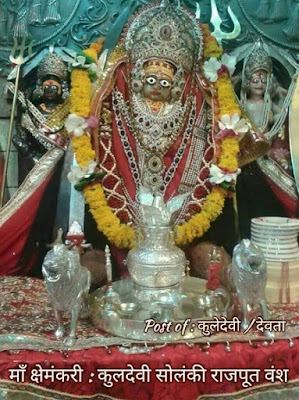Baghel Rajput
Baghel Rajput
 Rājpūt, Baghel.—The Baghel Rājpūts, who have given their name to Baghelkhand or Rewah, the eastern part of Central India, are a branch of the Chalukya or Solankhi clan, one of the four Agnikulas or those born from the firepit on Mount Abu. The chiefs of Rewah are Baghel Rājpūts, and the late Mahārāja Raghurāj Singh has written a traditional history of the sept in a book called the Bhakt Māla.1 He derives their origin from a child, having the form of a tiger (bāgh) who was born to the Solankhi Rāja of Gujarāt at the intercession of the famous saint Kabīr. One of the headquarters of the Kabīrpanthi sect are at Kawardha, which is close to Rewah, and the ruling family are members of the sect; hence probably the association of the Prophet with their origin. The Bombay Gazetteer2 states that the founder of the clan was one Anoka, a nephew of the Solankhi king of Gujarāt, Kumarpāl (A.D. 1143–1174). He obtained a grant of the village Vaghela, the tiger’s lair, about ten miles from Anhilvāda, the capital of the Solankhi dynasty, and the Baghel clan takes its name from this village. Subsequently the Baghels extended their power over the whole of Gujarāt, but in A.D. 1304 the last king, Karnadeva, was driven out by the Muhammadans, and one of his most beautiful wives was captured and sent to the emperor’s harem. Karnadeva and his daughter fled and hid themselves near Nāsik, but the daughter was subsequently also taken, while it is not stated what became of Karnadeva. Mr. Hīra Lāl suggests that he fled towards Rewah, and that he is the Karnadeva of the list of Rewah Rājas, who married a daughter of the Gond-Rājpūt dynasty of Garha-Mandla.3 At any rate the Baghel branch of the Solankhis apparently migrated to Rewah from Gujarāt and founded that State ]about the fourteenth century, as in the fifteenth they became prominent. According to Captain Forsyth, the Baghels claim descent from a tiger, and protect it when they can; and, probably, as suggested by Mr. Crooke,4 the name is really totemistic, or is derived from some ancestor of the clan who obtained the name of the tiger as a title or nickname, like the American Red Indians. The Baghels are found in the Hoshangābād District, and in Mandla and Chhattīsgarh which are close to Rewah. Amarkantak, at the source of the Nerbudda, is the sepulchre of the Mahārājas of Rewah, and was ceded to them with the Sohāgpur tahsīl of Mandla after the Mutiny, in consideration of their loyalty and services during that period.
Rājpūt, Baghel.—The Baghel Rājpūts, who have given their name to Baghelkhand or Rewah, the eastern part of Central India, are a branch of the Chalukya or Solankhi clan, one of the four Agnikulas or those born from the firepit on Mount Abu. The chiefs of Rewah are Baghel Rājpūts, and the late Mahārāja Raghurāj Singh has written a traditional history of the sept in a book called the Bhakt Māla.1 He derives their origin from a child, having the form of a tiger (bāgh) who was born to the Solankhi Rāja of Gujarāt at the intercession of the famous saint Kabīr. One of the headquarters of the Kabīrpanthi sect are at Kawardha, which is close to Rewah, and the ruling family are members of the sect; hence probably the association of the Prophet with their origin. The Bombay Gazetteer2 states that the founder of the clan was one Anoka, a nephew of the Solankhi king of Gujarāt, Kumarpāl (A.D. 1143–1174). He obtained a grant of the village Vaghela, the tiger’s lair, about ten miles from Anhilvāda, the capital of the Solankhi dynasty, and the Baghel clan takes its name from this village. Subsequently the Baghels extended their power over the whole of Gujarāt, but in A.D. 1304 the last king, Karnadeva, was driven out by the Muhammadans, and one of his most beautiful wives was captured and sent to the emperor’s harem. Karnadeva and his daughter fled and hid themselves near Nāsik, but the daughter was subsequently also taken, while it is not stated what became of Karnadeva. Mr. Hīra Lāl suggests that he fled towards Rewah, and that he is the Karnadeva of the list of Rewah Rājas, who married a daughter of the Gond-Rājpūt dynasty of Garha-Mandla.3 At any rate the Baghel branch of the Solankhis apparently migrated to Rewah from Gujarāt and founded that State ]about the fourteenth century, as in the fifteenth they became prominent. According to Captain Forsyth, the Baghels claim descent from a tiger, and protect it when they can; and, probably, as suggested by Mr. Crooke,4 the name is really totemistic, or is derived from some ancestor of the clan who obtained the name of the tiger as a title or nickname, like the American Red Indians. The Baghels are found in the Hoshangābād District, and in Mandla and Chhattīsgarh which are close to Rewah. Amarkantak, at the source of the Nerbudda, is the sepulchre of the Mahārājas of Rewah, and was ceded to them with the Sohāgpur tahsīl of Mandla after the Mutiny, in consideration of their loyalty and services during that period.
1Mr. Crooke’s Tribes and Castes, art. Baghel.
2Vol. i. part i. p. 198.
3See also a history of the Baghels, called Pratāp Vinod, written by Khān Bahādur Rahmat Ali Khān, and translated by Thākur Pratāp Singh, Revenue Commissioner of Rewah.
4Article Baghel, quoting Forsyth’s Highlands of Central India.







